 Tradewind
Knitwear
Designs by Lucy Neatby
Tradewind
Knitwear
Designs by Lucy Neatby
 Tradewind
Knitwear
Designs by Lucy Neatby
Tradewind
Knitwear
Designs by Lucy Neatby
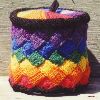
This was an exhibition of knitting held in Halifax, Nova Scotia in the winter of 1998 at the Mary E. Black Gallery. The exhibit was wide in scope, displaying many types of contemporary knitting. The focus was on the future of knitting but did not ignore its history. The items included wall hangings, free-standing objects, socks, mittens, bags, sweaters, vests, shawls, scarves and the infamous toilet roll covers (from knitters across Canada).
In the wake of the exhibit, the feedback from the exhibit has been
delightful and rewarding. To paraphrase but a few of the remarks
overheard, or read in the visitors book:
'It makes me want to go home and get my needles out again.'
'I lured my non-knitting family in, they were fascinated and didn't want to leave.'
'I have been surrounded by knitters and knitting all my life and yet
never realized that there was so much potential.'
'A sock is not just a sock.'
'Teach me!'
Join me for a glimpse of what you missed!
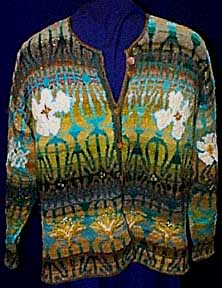
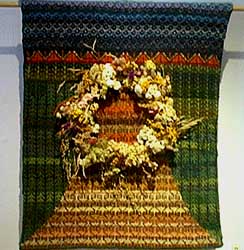
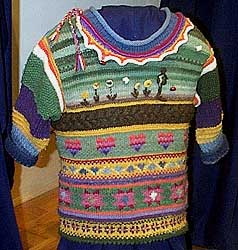
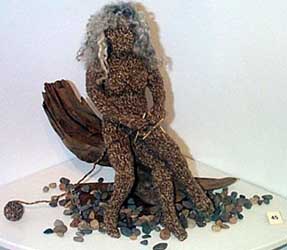
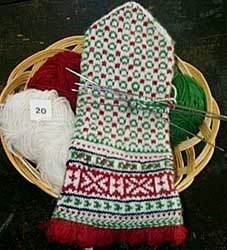
The toilet roll theme started as a joke to lure non-knitters in to view the exhibit. When 'toilet roll covers' with all their bazaar connotations were mentioned, even non-knitters would start to show interest - it might be amusement or revulsion, but they had to see them. Many knitters enjoyed the freedom to design on this small unimportant object and achieved wonderful results. The TRC exhibit has traveled to a number of Canadian locations and was disbanded at the end of 2000.
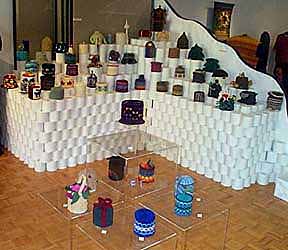
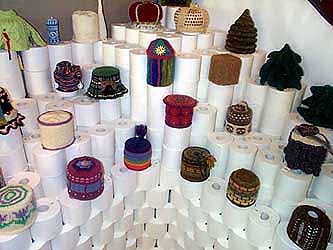
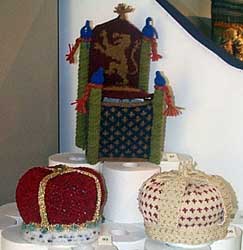
The idea of the exhibition grew from a perception of an injustice towards knitters; very few exhibitions are appropriate for knitting, resulting in the non-knitting world assuming that commercially available knitting is, in fact, a representative look at all knitting. Yet this knitting is largely done with an eye on the clock and the bottom line and for these reasons cannot be the cream of the crop. The exquisite yarns, careful technique, attention to detail, and wonderful designs lavished by 'home' knitters on their creations are rarely available for public appreciation. Here was a chance to literally bring fine knitting out of the closet(s)!
We had six working days to transform the space into whatever our imaginations and abilities would permit, and a small provincial grant for props. We also had a Gallery fitter and an installer; a bizarre experience for two wives' unaccustomed to immediate and willing service from men on the subject of shelves or screws. ( After a few days of having my every wish and whim granted I began to feel quite prima donna-ish!)
Despite many previous trips to the gallery, we were finding it difficult to imagine the overall placement of the pieces; a vague plan had been formulated, but how does one display two dozen sweaters in such a way that they are obviously 'on show', not retail goods in an upscale boutique? And then there were the 30 mittens, 70 socks, 65 toilet roll covers, half a dozen bags, wall hangings, and several free-standing pieces. (Exactly how many sweaters did we have? Some were still coming in. Would they all arrive?) We wanted them to be three-dimensional and visible from all sides; some form of anthropoid display units were obviously required. This was translated by the capable gallery jack-of-very-many-trades into rough-hewn, slope-shouldered, person-height, T-shaped wooden 'people': a cheap and functional design. That was all very well, but these mannequins certainly needed fleshing out. Off i went to a shipping supplier for 250 feet of giant bubble wrap. Did you know that one roll of bubble wrap and a porcelain toilet fill a Chevy Sprint?
It was decided that to bring together the great diversity of colors and styles of sweaters and vests the padded T pieces should be draped with a plain deep blue fabric. The cheapest suitable and plentifully available was chosen - we used over 120 meters.
The socks and mittens were laid out on tables to determine exactly what we had. The idea was to run a washing line' from window pillar to window pillar and hang the socks and mittens with plain wooden clothes pins, to make both a domestic analogy and suggest a Christmas garland (as the show was open over the holiday season). Having laid the pairs and singles out, it was decided that we had sufficient numbers to display one of each only - as I had hoped; the idea was to look at each item as an individual art work, not simply part of a pair. There was much shuffling and arranging of sock colors, styles and lengths, and height of clothesline-line' adjustment, so that they could be clearly seen above the people' but not be too high for close inspection.
A recurrent nightmare was: how do we best display the great diversity of wonderful toilet roll covers without letting them take over the entire space? We wanted to raise a laugh, but to avoid being made a laughing stock. In our irreverent fashion we were wanting people to take knitting seriously.
We had discussed the idea of erecting an outhouse. This was rejected as too confined and claustrophobic and it would have chopped up the space unacceptably. After a number of false starts, the entire local government supply of spare toilet paper rolls was requisitioned and unwrapped. A plinth of cardboard boxes was built and clad in toilet rolls stacked in staggered columns to make nooks and alcoves for each of the TRCs. Each little knitted gem would have its own space and could be viewed from above and around. The TRC display came to be in an L shape, with the projecting arm hidden from immediate view on entering the gallery by a tapered fabric-covered wall constructed of Styrofoam. The corner focus of the display had at one point been planned to be the toilet on a pedestal. The presence in the gallery of the aforementioned white vessel caused both considerable mirth and not a little cringing. As the toilet-roll encrusted structure grew it began to be evident that the toilet would be unnecessary and a far better focus would be the three regal theme TRCs, one of which ( a three-dimensional medieval throne ) already graced the cover of our catalog. With much relief the toilet bowl departed.
The first few days seemed to involve a lot of emptying boxes, sorting pieces, moving items from A to B and then back again, head scratching, writing of lists, coffee, standing back and squinting, all punctuated by periodic loud shots' ringing out - as someone stepped back onto a piece of stray bubble-wrap on the floor. The show didn't seem to be going anywhere fast.
The 'people' were stuffed, mounted and dressed and pushed into a crowd out of the way. The socks and mittens were hung. The 'domestic' end of the show was alluded to with the aid of an old table, a swift with yarn and nostepinne and a Latvian mitten in progress. A further evocation of domesticity were the basket of socks (all the other halves ), knitted rugs and some free standing socks (stuffed and lined up to suggest a row of footwear) below a coat rack, from which we hung the bags. The scene was completed with a number of wooden chairs to display shawls and wraps. A show seemed to be emerging; perhaps we were going to make it after all?
At the entrance of the exhibit we planned an area with non-traditional pieces: the knitted silk covered book, the cotton and sand vase, and the beach blanket of rounded beach stones double-knit into a fabric of fishing line. Perspex plinths were brought in and arranged to display these and lend the best possible view of the show as a whole. Wall space was allocated to the various hung pieces. Things were beginning to look good - fortunate really, time was running out fast. Now that all the areas of the show were defined we could arrange and group the 'people'. Color, technique and style determined who would stand with whom! Some of them held sleeves with each other, others formed family groups with the tiny 'child' mannequins.
Lighting and cataloging were the next objectives. The catalogue essay had been written months before and the cover pieces chosen and photographed. But the precise content of the exhibitor list had still to be completed. This was a subject for debate. What is an original design? When does a piece altered and adjusted and developed by the knitter become their own? Should designers names be listed too? I favor the analogy with composers and musicians - it makes the music no less wonderful if the musician didn't compose the work but the composer would still get a mention. This still left grey areas, but complete originals were starred, and others listed as 'inspired by' and both knitters and designers I trust received their due acknowledgments.
As we carefully checked the items of the alphabetical list, the awful truth began to dawn. We had a rogue blue mitten! We had had a last minute flurry of local entries, the donors all well known to us. The mitten had caught us with our guard down and didn't sport a uniquely numbered tag. After a series of phone calls to as many of the last minute entrants as we could recall, we eventually tracked down the owner - it was a worrying time. Back to the numbering again. By the end of the day the catalogue insert was completed and all the pieces numbered, listed and labeled. Time to collect our guest speaker Cindy Nicholls, President of the Knitting Guild of Canada, from the airport.
The day of the opening dawned without dire meteorological predictions. It was to be 'primping and preening' day. Each piece was subjected to close and critical scrutiny. Cindy took up a businesslike stance behind the ironing board and proceeded to iron the fabric which adorned each 'person'. ( We were later told she was the first ever guest speaker who has actually helped with the set up of an exhibit. Aren't knitters wonderful? ) Buttons were checked, neck lines supported and extra body building given to any undernourished 'people'. The floor was swept and we were ready.
Despite the charms of Elvis Stoiko resulting in a serious parking space paucity, there was a full house for the opening and the rest, as they say, is history!
My thanks to all the exhibitors, Corrie Watt (co-curator), Stephanie
Dean-Moore, Cindy Nicholls, the staff at the NS Center for Craft and
Design, and the many members of the NS Knitting and Cocoa Society,
Lucy Neatby
Tradewind Home
TRADEWIND KNITWEAR DESIGNS
45 Dorothea Drive, Dartmouth, NS, B2W 5X4, Canada
All images and text Copyright © 2004; Lucy Neatby, Tradewind Knitwear Designs